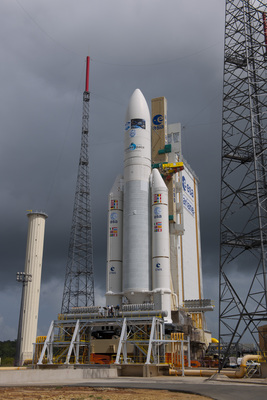European Space Agency
| European Space Agency | |
| Established | 1975 |
|---|---|
| Headquarters | Paris, France, Earth |
| Primary spaceport | Guiana Space Centre |
| Website | www.esa.int |
Contents
History
The European Space Agency (abbreviation: ESA) was established in 1975 as a merger of the former European Launch Development Organization (ELDO) and the precursor of the European Space Agency, the European Space Research Organization (ESRO). Despite its name ESA is not an agency or body of the European Union, but most of the member states of ESA are also members of the EU.
The first ESA missions were done purely with US launch systems because ESA had no native launch capacity. ESA and NASA joined in a large number of research projects, including ESA-sponsored space shuttle missions with the European Spacelab on board[1].
In 1979 ESA built its first self-developed and -built launcher system, the Ariane 1. In the next 30 years ESA launched nearly 200 commercial and scientific payloads, with only 11 full or partial failures. The Ariane 4 was considered the most reliable space launch system before waved spacecraft appeared in 2007.
Since the end of the Cold War ESA started a cooperation program with Roscosmos, the space agency of the Russian Federation. This cooperation included flights to the MIR space station, joint research programs and sharing launch facilities.
ESA was part of the international community that built and maintained the International Space Station. They were the lead agency in maintaining the station between February 2013 (when NASA pulled out of the Space Station Intergovernmental Agreement) until May 2014 (when the contract for the station's maintenance was awarded to the Artemis Foundation). ESA and its member states built multi-purpose logistics modules (MPLM) for the ISS[2].
In 2003 the ESA launched the SMART-1 probe, an ion drive equipped research satellite that arrived in an orbit around Earths moon in mid 2005. SMART-1 was crashed into the moon in September 2006 for scientific purposes.
History (post wave)
When the first batches of handwavium began to appear in small laboratories, scientists did not recognize that they held the key to a new age of space exploration. When Fen began entering space ESA was surprised like most other space agencies.
Not being a direct agency of a government or the EU saved ESA from being shut down in the wake of the Professors “Reign of Terror” in the winter of 2007. Before the member states of ESA could agree on new rules “to prevent misuse of dangerous substances in European spaceflight” several governments had already begun clandestine handwavium research programs in order to apprehend The Professor at great expense. Many ESA representatives were forced to resign when this was revealed. Others were jailed for redirecting huge amounts of state owned money for an illegal bounty against the Professor.
With the availability of cheap surface-to-orbit lift capacity via Fen contractors, ESA stopped further development on the Ariane launcher system in 2009 and started to focus on improved hardtech systems for space probes and satellites. The last scientific mission done by an Ariane 5 launcher was the Herschel Space Observatory at Lagrange point 2. ESA stayed a pure hardtech space organization, denying all rumors about secret experiments with handwavium.
In 2010 ESA bought SR-06 from the Rockhounds and converted the interior into a satellite maintenance depot. The ability to repair commercial satellites in a zero-g facility in orbit helped ESA to maintain their ties with commercial satellite companies. ESA has contracts with several owners of large waved trucks to move satellites between their depot and the satellites' intended orbit.
It is known that supporters of ESA supplied them with a copy of the first edition of the Whole Fenspace Catalog after Serenity-Con. ESA considers the Catalog a blueprint to restart hardtech exploration of space. It is known that ESA has upgraded the life support system on SR-06 several times since this.
When the Soviet Air Force announced the founding of EXFOR in 2013, ESA sponsored several scientific instruments and researchers for the Delta Pavonis expedition. Since then, ESA tried to become a permanent part of the Soviets' space expeditions.
In late 2014 ESA announced that they would start testing a new generation of ion drives in early 2015 to “open the solar system for cheap scientific research”. In addition to this they are lobbying their members for the necessary money to develop and build a space elevator near Guiana Space Centre at Kourou in 2020.
With the launch of the prototype Interplanetary Space Vehicle Thor Heyerdahl ESA proved that they wanted to join the nations with the ability to visit the whole solar system. In March 2015 the ion drive equipped hardtech ship flew its crew to Mars within less than a week. After the flight ESA announced the plan to built up a series of reusable ISVs for operations in the whole solar system.
Stories
ESA has been a main participant in the following stories
Notes
- ↑ Starting with the STS-9 mission in 1983.
- ↑ The Donatello and Raffaello MPLMs are still used by Artemis for ISS reprovisioning. The Leonardo module was permanently docked to the station in 2010
| ||||||||||||||||||||
